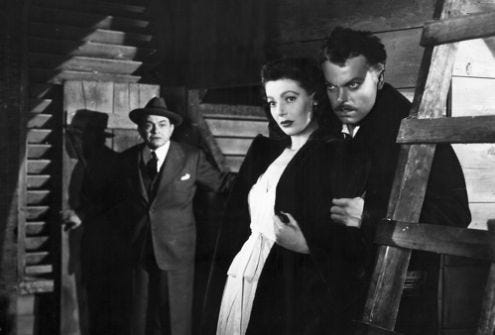The Stranger

A lot of movies from the late '40s and '50s focus on creating distrust in suburban America. Most of them were threats against communism, like "Invasion of the Body Snatchers" or the superb Hitchcock thriller "Shadow of a Doubt." One of the more underappreciated entries to the subgenre was the Orson Welles film "The Stranger."
Edward G. Robinson ("Scarface," "Five Star Final") is Mr. Wilson from the War Crimes Commission, who is determined to track down the infamous Nazi Franz Kindler. There is no photograph of Kindler; in fact, the only person alive who can identify him is the imprisoned Konrad Meinike.
Mr. Wilson releases Meinike and follows him to Harper, Connecticut. There, they find Kindler (Welles), who has assumed a new life as Charles Rankin. He’s a respected professor at the college and is getting married to Mary Longstreet (Loretta Young). In order to maintain his cover, Kindler murders Meinike, and that is when everything starts to unravel.
As a director, Welles does a very good job playing with the film-noir model and experimenting with presentation. The opening is not perfect, but the rapid editing is a strong way to establish discomfort. The use of shadows is a staple of noir, but Welles cleverly uses them to creepily transition between scenes.
Welles shows his brilliant eye for shot composition, but this one doesn’t seem to be as tight as some of his other films. The pacing gets away from him at times and Young’s acting needed to be reined in. (Also, he should've probably learned the rules of checkers if there were to be several scenes of it.)
What really has the lasting impact with this film is how it handles the character of Kindler/Rankin. There is a very impressive ambiguity about how to treat a character who is clearly a villain on paper, but there isn’t a rush to stop him. There is sympathy toward a man who wants to start over, but Welles doesn’t downplay his Nazi past. In fact, in one sequence, it’s especially horrifying as Mr. Wilson shows footage from his past.
It’s a fascinating movie that would do well with a new Blu-ray edition. Unfortunately, this new transfer isn’t too impressive. The only bonus feature on the disc that isn’t a trailer is a 1-minute transfer demo to compare and contrast the differences in the versions. There is a clear cleanup of pops and contrast, but it’s nothing compared to other recent conversions.
Film: 4 Yaps Extras: 1 Yap


